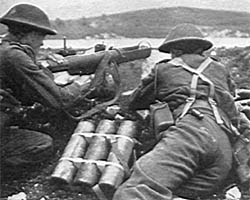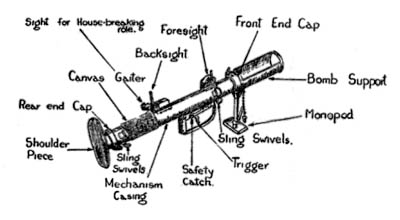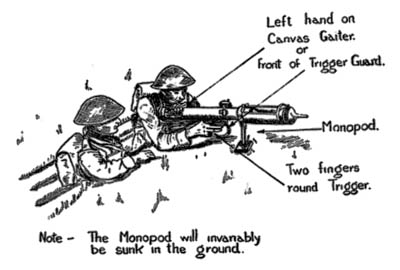 The Projector, Infantry, Anti-Tank (PIAT) was an infantry anti-tank weapon used by the British during World War II. The PIAT used a lightweight steel tube which held a hollow-charge bomb and a heavy firing spring. When the PIAT was cocked, the firing spring was compressed and when the trigger was pulled, the firing spring pushed a spigot forward which fired the propelling charge in the bomb. The recoil of firing would then automatically cock the weapon for firing again.
The Projector, Infantry, Anti-Tank (PIAT) was an infantry anti-tank weapon used by the British during World War II. The PIAT used a lightweight steel tube which held a hollow-charge bomb and a heavy firing spring. When the PIAT was cocked, the firing spring was compressed and when the trigger was pulled, the firing spring pushed a spigot forward which fired the propelling charge in the bomb. The recoil of firing would then automatically cock the weapon for firing again.
The PIAT was light (32 pounds) with an effective range of 115 yards against tanks and 350 yards against buildings and other targets. The PIAT’s hollow-charge bomb was capable of penetrating 100 mm (4 in.) or armor. The PIAT had a number of disadvantages compared to the American bazooka, and it was generally an unpopular weapon. However despite its drawbacks, the PIAT did give the British infantry an effective anti-tank capability. Six British and Commonwealth soldiers received the Victoria Cross for use of the PIAT.
The following instructions for loading, aiming, and firing the PIAT are excerpted from the British training manual Projector, Infantry, Anti-Tank, Small Arms Training, Volume I, Pamphlet No. 24, 1943.
LESSON 2.—LOADING, AIMING AND FIRING
1. Introduction
When choosing a firing position for the projector, it should be remembered that the weapon is easier to swing with a moving target if the elbows are not rested. Owing to its limited range every effort must be made to obtain concealment. A slit trench should be dug whenever time permits.Two men will be required to maintain the projector in action. No. 1 will fire; No. 2 will load and assist No. 1 in every other possible way.
2. Loading
Before loading. see that the projector is cocked. No attempt must EVER be made to place a bomb over a protruding spigot. When time permits No. 2 will also make certain that the guide ring is sound and firm on the bomb tail.To load, No. 2 removes the dust plug from the bomb tail, then the muzzle plug With the drum tail to the rear, the bomb is placed in the bomb support nose first so that the guide ring is engaged between the loading guide plates. No. 2 must make certain that the tail is pressed as far down as possible by pressing on the drum tail ring with the flat of his hand; while doing so he must take care not to place his fingers in front of this ring. No. 2 will immediately prepare another bomb for loading….
4. Sights and aiming
Raise the foresight and becksight. The foresight is in the form of a bead; the backsight consists of two apertures, the top sighted for 100 yards and the bottom for 70 yards.Rules for aiming
Against head-on and retiring tanks: keep the furesight in the centre of the aperture and aim at the centre of the tank.
Against crossing tanks: Keep the foresight in the centre of the aperture and aim one length in front of the tank from the centre. The swing of the projector must not be checked at the moment of firing.
These rules must be applied with common same. Depending on the range and speed of the tank, the lead may have to be lengthened or shortened. Moreover, when using the 100-yard aperture, aiming up and down may be necessary, since a comparatively small increase or decrease in range affects the trajectory of the bomb considerably. The top aperture should be used for ranges between 85 and 115 yards, and the bottom one for ranges below 85 yards. It should be noted that the distance from the top of the bead to the shoulder of the foresight, when viewed through the backsight aperture, represents a height of 6 feet at 100 yards.
5. Holding and firing
Raise the shoulder piece into the shoulder. Push the safety catch forward. Hold the projector firmly into the shoulder with the left hand either over the webbing gaiter or grasping the front of the trigger guard: place the thumb of the right hand behind the trigger guard grip and the first two fingers on the trigger. Aim as taught.To fire, press the trigger when the aim is correct. The trigger pressure is long and heavy. After pressing the trigger there is an appreciable delay before the bomb is fired; it is essential to maintain correct hold and aim during this delay.
After firing, No. 1 will observe the flight of the bomb. No. 2 will reload immediately, first making certain that the spigot is not showing. Owing to the limited range of the weapon, quick reloading is essential in case the first bomb misses the target. No. 1 must take care to keep his finger clear of the trigger while No. 2 is reloading.












Why didn’t the British just adopt the U.S. bazooka?
Cool pictures.
Great post, bookmarked your site, will be back later.
To Scott
Because they are British and had different supply lines.
The U.S. provided a large number of bazookas to Russia under Lend Lease. Wasn’t the Russian Front where the Germans captured the bazooka and copied it?
The Germans copied M1A1 rocket launchers that they captured in North Africa from the Americans.
Excellently written. Thank you for your knowledge.
good article.
Great post thanks. x
The American Bazooka had inferior penetrating power on armor to its German equivalent, the Panzerschreck, and American troops used it in preference to the Bazooka when they could get their hands on them (they also used the Panzerfaust on occasion).
Major Robert Henry Cain got his VC when he took on a Sturmgeschütz III assault gun single-handedly with his PIAT, firing it several times from the hip till he had stopped the tank. Some wag suggested that considering what the recoil on the PIAT was like, he probably deserved the medal just for having fired it from the hip alone. 🙂
Very helpful article. Thanks for this.
I was looking for this the other day. i dont usually post in forums but i wanted to say thank you!
Yada. Yada.
We need more info on the Red Army in world war II. Even more stuff on the Germans, Romanians, Italians, Hungarians and Slovaks.
American info is a dime a dozen. The Brits, ehh, not much to say about them that ant been said.
Lets see something we don’t know. Research info?
Amazing
Nothing kicks like a PIAT. Thanks again 😉